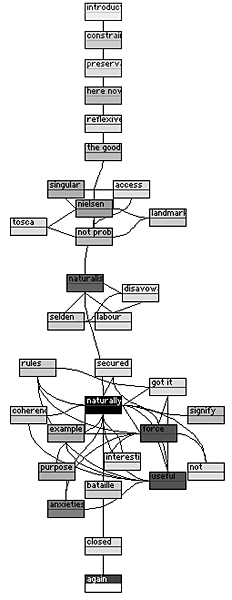
|
Dear reader,
This is the fourth or fifth academic hypertext essay I have had published. By "academic hypertext essay" I mean scholarly work that can only be realised electronically and has been written with particular hypertext practices in mind. This includes, for example, multilinearity, repetition, mixed media, and multivocality. These are qualities that influence not only what I write, but also how I write. Once I begin to write in hypertext, from the page up as it were, a different writing practice appears to emerge.
This means that this essay is part of an ongoing experiment in method that is a result of my experience teaching and researching hypertext as a way of writing, as a method of engaging with ideas and writing. As an experiment it explores what it might mean to write in a way that is less concerned with closure than to propose problems that remain open. Similarly, as a multilinear work there is no distinction drawn between the body of the work and footnotes, and the tone may vary from ironic to sustained critical commentary and back again - always along a link. Hence this essay attempts to practice what it describes - I hope less in the spirit of self-reflexive posturing than in an effort to find what does, and does not, work.
As a result the work can often appear lengthy and repetitious. The argument, in contrast to its more usual explication in linear writing, often exists via the links and the relations they establish. As you read this essay, please keep in mind that if something appears to need explication then the links available from where ever you happen to be probably provide at least some of this additional detail. However, like the traditional essay, sometimes answers to problems raised only appear after they have been signalled - the linking is not saturated where all questions, problems, answers, asides, commentary and discussion are immediately interlinked. There are pauses between the more densely linked moments.
There are various assumptions I make within this essay. Some of these are commonly recognised within the literature, others refer to material that I have researched and written about previously, and still others await (and need) further attention. It is written from the view that hypertext is part of a developing electronic literacy that alters existing paradigms of writing and reading. This shift is not just one of dissemination and publication but also alters the possibilities for writing as a material practice. The implications of this change are, for the most part, unclear to me.
Finally, a note on spelling: This essay uses Australian English spelling which has been retained for publication as part of the difference and plurality that an engaged hypertext practice seeks and endorses. There are many ways of writing and this essay is stuttering its way towards one of them.
read on....
(Adrian Miles)
|